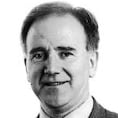Prague has to be one of the most beautiful cities in the world. Crossing the St Charles bridge at night with the floodlit castle ahead is an experience which is not of this world. With its spires, turrets, its wide, graceful river and elegant, cobbled squares, this is a city for young men and women. The romantic young are everywhere, in one another's arms. Rarely has the human spirit chiselled such beauty from rock and stone and every blooming thing. Now capital of the Czech Republic, Prague still wears the trappings of its grander past as centre of the Hapsburg empire, and with an unconscious grace. Indeed there is such an air of cosmopolitan sophistication it borders almost on disdain. No wonder it attracts armies of tourists every year now - an estimated 20 million in 1996.
Apart from the stunning cityscapes, people also come to pay homage to its great classical music heritage, and to listen. Works by the great classical composers are performed every evening at venues all over the city, particularly around the Old Town Square area, and the prices are cheap.
Many tragedies
There are also the city's many tragedies to be remembered: the spot on Wenceslas Square where Jan Palach burned himself to death in protest at the 1968 Soviet invasion; the statue of Jan Hus in Old Town Square, commemorating a man burned as a heretic in 1419, and once covered with a black shroud as a further protest at the Soviet invasion; the Old Jewish Quarter, whose occupants were almost all exterminated by the Nazis, including Franz Kafka's three surviving sisters. He might have met a similar fate himself, had he not already died from TB in 1924.
There is the house where Kafka was born, literally in the shadow of Saint Nicholas's church, off the Old Town Square. He lived most of his life in that part of Prague. It was the world of his imagination, the world of The Trial, Metamor- phosis and The Castle, which overshadows his world still from its imposing height across the river.
There's Narodny Street where, on November 17th, 1989, 50,000 students, allegedly commemorating the execution of nine students by the Nazis in 1939, but really responding to the fall of the Berlin Wall a week earlier, were cornered and beaten by police. Over 500 were injured and 100 arrested. That was the beginning of the socalled"Velvet Revolution" which ended with a Government of national understanding and Vaclav Havel as president.
There is even a strong Irish connection with the city, going right back to St Gall, after whom Havelske Mesto - a market quarter built in 1230 - is named. It is dominated by the Church of St Gall, an imposing baroque building where Jan Hus preached his unacceptable reforms.
Today Ireland is represented in Prague by missionaries of a different sort. They bring pubs and rock music. Kiss FM, a very popular radio station in Prague, is owned by Dublin's 98FM, while there are at least five Irish pubs in the city. A brief but committed investigation uncovered three: the James Joyce, the Molly Malone, and O'Che's - which is named after Che Guavara. It is adorned with Guevara memorabilia and Cuban flags, and it sells Cuban cigars and Havana rum as well as Guinness and Irish whiskey. A framed newspaper clipping on the wall explains all about Che's Irish grandmother.
In that truest of Irish traditions O'Che's has already experienced `the split'. Half the partnership has left and set up the James Joyce only yards away.
Irish embassy
The Irish embassy in Prague, opened just two years ago, is run by the very courteous ambassador, Ms Marie Cross, while that most helpful and efficient man, Mr Aidan O'Hara, is first secretary. Like so many of our foreign affairs staff, particularly abroad, they make you feel proud.
A particular insight into Prague's citizenry, especially its men, was offered in O'Che's by one young Irish woman. Over a glass of beer - probably the best in the world; no wonder the Czechs drink more than any other Europeans - and barbecued chicken, she spoke of her disillusionment. She has been in the city a few years, and has fallen out of love with the Czechs.
Handsome Irishmen
She no longer thinks they are even good-looking. I mean, she was at a party in Dublin just recently and she was so struck by just how handsome Irish men really are that she just stopped and, well, stared at them all night. For ages. I mean,
it was amazing; Irish men had much more spirit too, that's why they had stood up to the English all those years. I mean, Czech men had no backbone. That was why they were invaded so many times, from all sides. She agreed with the suggestion that it should be compulsory for all Irishwomen to spend time in Prague.
Her companion agreed with most of what she had to say. Colonial English, born in Kenya, he had worked all over Eastern Europe. But he was more expansive in his views. He just didn't like any Eastern Europeans. They were all dour, cynical and untrustworthy. He believed this was due to their history: invasions again and again, and all that.
He had problems with the Irish too, and with black Africans. After all, let's face it, who built those countries? And now look at what they are doing to them. He was not amused by a tale I heard from Irish friend some years about white Rhodesians/ Zimbabweans he had worked with for a few years. It concerned one such "Rhodie" who, frustrated by delays in getting a job done had shouted: "Give me tin blicks [blacks] and I'll do it myself."
And by the way, the next time you see that Cadbury's Flake advertisement on TV, study the background detail. It was made on Prague's King Charles bridge. But in real life you'll never see it so empty.
